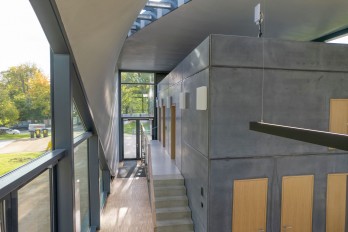Reducing carbon emissions by at least 30% using sustainable concrete

Several months ago, news emerged about the project called Populus, hailed as the "nation's first carbon-positive hotel." This 13-floor, 130,000-square-foot cement tower in New York City's Little Italy garnered attention for its triangular layout and eye-shaped windows. The construction began in Denver, Colorado, last year, with the aim to become operational by spring 2024.
The key factor setting Populus as a carbon-positive project is its commitment to sustainability, encompassing practices such as waste reduction and the use of fewer finishing materials. However, the driving force behind its eco-friendly initiative is sustainable concrete.
ECOPact, developed by Holcim, a leading supplier of sustainable building materials, is an optimized, low-carbon concrete enriched with significant amounts of supplementary cementitious materials (SCM). ECOPact boasts lower embodied carbon content compared to conventional concrete, making it an attractive choice for various applications.
Holcim has structured ECOPact into a three-tiered system: (i) ECOPact (30–50% reduction in carbon emissions), (ii) ECOPact Prime (50–70% reduction) and (iii) ECOPACT Max (70–90% reduction). These tiers can be further enhanced with the incorporation of recycled concrete aggregates from the ECOPact+ range. It is mentioned that as the built environment strives to minimize its impact on the planet, innovative materials emerge as potential catalysts for change, meeting the desires of architects, engineers, and contractors.
In the case of the Populus hotel, sustainable concrete played a crucial role in the design process. Approximately 65% of the total cubic yards of concrete used in the project consisted of ECOPact, resulting in an expected reduction of 765 tons in embodied carbon compared to traditional concrete. A similar success story unfolded at 55 H Street, a residence hall at Georgetown University. Faced with the challenge of requiring a concrete blend capable of achieving a 28-day design strength of 5,000 psi and a high-early strength of 3,000 psi within two to three days, the project team turned to ECOPact. The outcome was a sustainable building described as one of the most sustainable buildings in D.C.
Sources: bdcnetwork.com, holcim.com
Want to read more like this story?

The world’s first carbon concrete building constructed by researchers in Germany
Nov, 10, 2022 | NewsThe first building made of carbon-reinforced concrete was inaugurated in September after two and a...

Zero-cement concrete will reduce the environmental impact in construction industry
Aug, 08, 2024 | NewsDue to the climate crisis and the high CO2 emissions of concrete, engineers and scientists are seek...
Concrete Structures
Jan, 01, 2019 | EducationConcrete structures are constructions that utilize concrete as the primary building material. Conc...

Sustainable materials can be used in construction to decrease environmental pollution
Apr, 30, 2024 | NewsEfforts to reduce emissions in the building sector typically focus on operational aspects like heat...

Concrete that traps CO2 emissions for good
Jul, 16, 2018 | NewsA new method to produce concrete that traps harmful CO2 emissions and increases the compression stre...

The prospects for carbon-neutral buildings
Oct, 27, 2023 | NewsIn the United Kingdom, buildings account for 33% of greenhouse gas emissions and 40% of global ener...

Concrete is a climate disaster and thus it’s time to clean it up
Oct, 29, 2021 | NewsFor soaring bridges, dramatic skyscrapers and even the path around your local park, builders love c...

10 state-of-the-art sustainable materials that will alter construction industry
Jun, 10, 2024 | NewsIn 2024, sustainable materials become state-of-the-art in construction since the construction indus...

The longest 3D-printed concrete bicycle bridge
Sep, 09, 2021 | NewsThe Dutch city of Nijmegen has now the longest concrete 3D-bicycle bridge in the world. The length...
Trending

Spectacular interchanges around the world

New Release - STAAD.Pro 2024 - 2

ADINA 2025 for Structural WorkSuite

ADINA 2025 New Release!

Concrete Buildings as Rechargeable Batteries

Powerful earthquake shakes central Philippines, dozens killed

Indonesia school collapse: three fatalities and dozens injured

